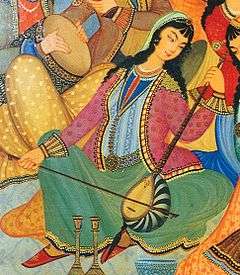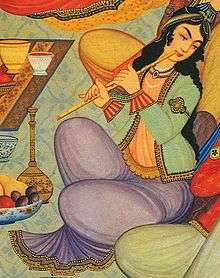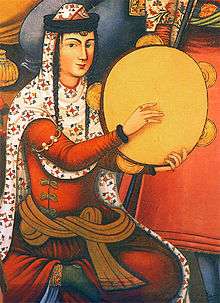Kurdish tanbur
 | |
| String instrument | |
|---|---|
| Other names | Tembûr, Tanbour, Tanbūr |
| Classification | Plucked string instrument |
| Related instruments | |
Kurdish tanbur (Kurdish: tembûr تهمبوور) or tanbour (Persian: تنبور),[1] a fretted string instrument, is an initial and main form of the tanbūr instrument family, original of and unique to the Kurdish people.[1][2] It is highly associated with the Yarsan (Ahl-e Haqq) religion in Kurdish areas and in the Lorestān provinces of Iran.[2] It is one of the few musical instruments used in Ahl-e Haqq rituals, and practitioners venerate the tembûr as a sacred object.[3] Another popular percussion instrument used together with the tembur in Yarsan spirituality is the Kurdish daf.
Nowadays tembur is played all over Iran, but Kurdish tembur is mainly designed and has been for centuries in the Hawraman region in the provinces of Kermanshah Province, Kurdistan Province and Lorestan. The more traditional and accepted temburs originate from the cities of Kermanshah, Sahneh and Gahvareh. Tembur is locally called tamur, tamureh, tamyarah or tamyorah (تَمیُرَه ، تَمیرَه ، تموره, تمور) there.[1] The Kermanshah tembur should not be confused with saz also called tembûr in Kurmancî Kurdish.
The tembûr measures 90 cm in length and 16 cm in width.[2] The resonator is pear-shaped and made of either a single piece or multiple carvels of mulberry wood.[2] The neck is made of walnut wood and has 13 or 14 frets or, arranged in a semi-tempered chromatic scale (one of the only middle eastern musical instruments not microtonal).[2] The tembûr employs three metal strings that the first course is double. The melody is played on the double strings with a unique playing technique of strumming the right hand with each finger separately when motioning the hand upwards from the position beneath the strings.
Notable players
Most musicians that play the tembur are ethnic Kurds from Iranian Kurdistan and are adherents of the Yarsan faith. More famous players do not only play within Iran but also have gained international recognition. The music of the tembur involves Kurdish epics crafted centuries ago, sacred to the Yarsans. But musician improvisation and intuition makes the sound of the tembur very adaptive.
See also
References
- 1 2 3 "تنبور (یا تمبور/ طنبور)". Encyclopaedia Islamica. Retrieved March 3, 2013.
- 1 2 3 4 5 Scheherezade Qassim Hassan; Morris, R. Conway; Baily, John; During, Jean (2001). Sadie, Stanley; Tyrrell, John, eds. The New Grove Dictionary of Music and Musicians. xxv (2 ed.). London: Macmillan. pp. 61–62.
- ↑ Shiloah, Amnon (2001). Sadie, Stanley; Tyrrell, John, eds. The New Grove Dictionary of Music and Musicians. xiv (2 ed.). London: Macmillan. p. 40.
Sources
- Darvishi, Mohammad-Reza (2002) [2001]. "Kermanshahan tanbur (تنبور - کرمانشاهان)". Encyclopedia of the Musical Instruments of Iran. Tehran, Iran: موسسه فرهنگی هنری ماهور (Mahour). ISBN 9646409458.


